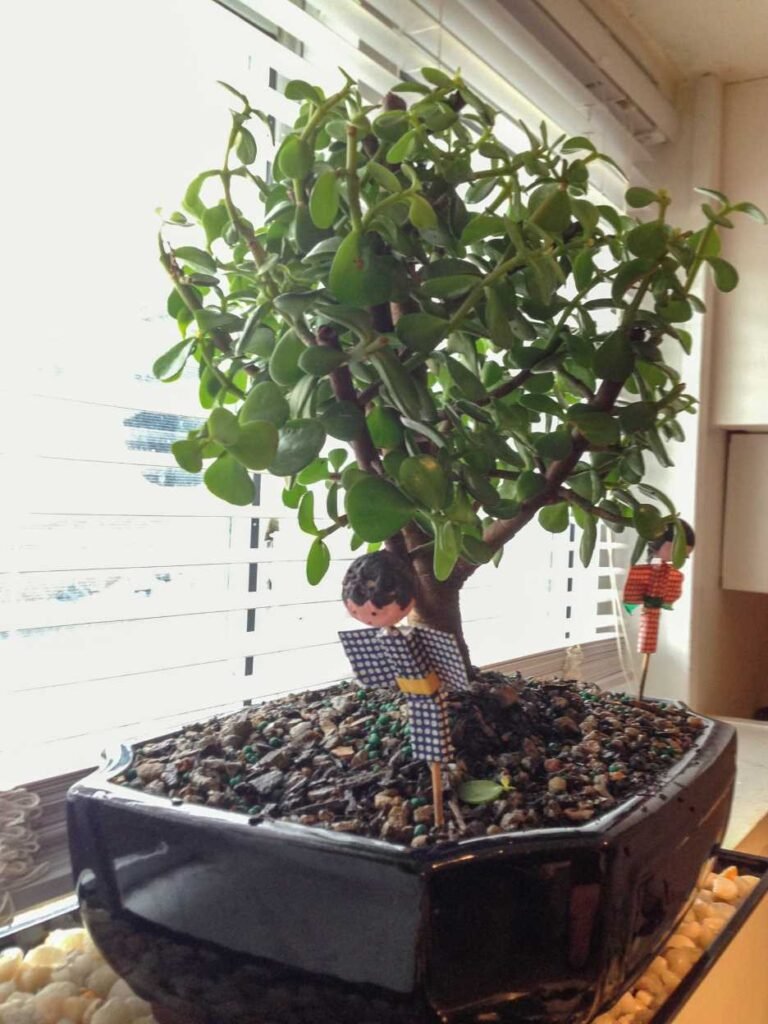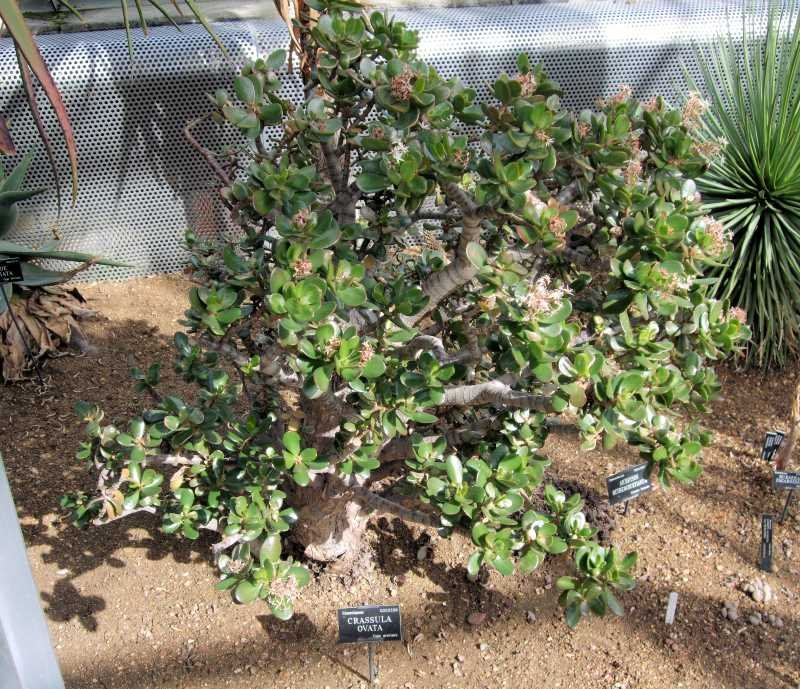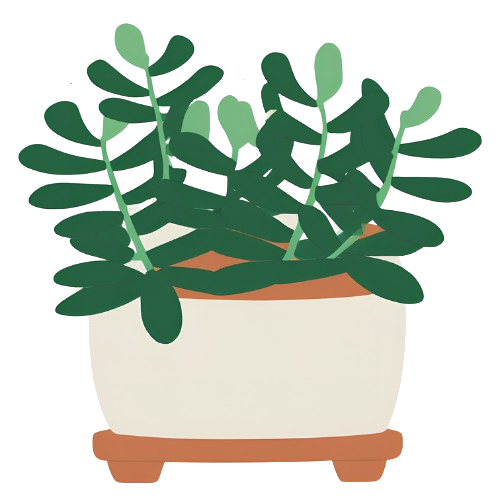Jade plants make great bonsai trees. I’ve grown jade bonsai for years. Today I want to share what I know about this fun hobby.
Jade plants are perfect for beginners who want to try bonsai. They grow well indoors and need little care. You can shape them in many ways. They live a long time too.
Table of Contents
What Is a Jade Plant Bonsai?

A jade plant bonsai is a small jade plant grown in a shallow pot. We trim and shape it to look like a tiny tree. The jade plant (Crassula ovata) has thick stems and oval, fleshy leaves. The leaves store water, which helps the plant survive dry times. This makes jade plants easy to care for.
Jade plants come from South Africa. They can grow up to 6 feet tall in the wild! But as bonsai, we keep them small on purpose. We do this by trimming roots and branches and using small pots.
The word “bonsai” means “planted in a container” in Japanese. It is an old art form from Japan and China. People have made bonsai trees for hundreds of years. While jade plants are not part of that old tradition, they work well as bonsai for modern homes.
Why Choose Jade for Bonsai?
There are many reasons to pick jade plants for bonsai:
- They grow slowly, so you won’t need to trim them all the time.
- Jade plants have thick trunks that look like old trees.
- They have small leaves that look right for the scale of bonsai.
- Jade plants can live for decades with good care.
- They do well in dry indoor air, unlike many other bonsai trees.
- You can grow them from cuttings, so it’s easy to start new ones.
- They cost less than many other bonsai trees.
- They don’t drop leaves all over your house like some trees do.
On top of all that, jade plants are said to bring good luck and wealth in some cultures. In fact, they are often called “money plants” or “lucky plants.”
Getting Started: Choosing Your Jade Plant
To start a jade bonsai, you need to find the right plant. You have two main choices.
Option 1: Buy a Grown Jade Plant
The fastest way to start is to buy a jade plant from a store. Look for one with:
A thick trunk (or main stem) Good branch structure Healthy green leaves No signs of bugs or disease
Bigger plants cost more but give you more to work with right away. Even a small jade plant from a store can make a good bonsai with time and care.
Option 2: Grow from a Cutting
You can also start a jade bonsai from a cutting. This takes longer but costs less. Plus, you can take cuttings from a friend’s plant for free!
To grow from a cutting:
- Cut a healthy stem from a jade plant (4-6 inches long is good).
- Let the cut end dry for 2-3 days until it forms a callus.
- Plant the cutting in cactus soil mix.
- Water lightly and place in bright, indirect light.
- Wait for roots to grow (about 3-4 weeks).
Cuttings take time to grow into plants with thick trunks. It might be years before a cutting looks like a proper bonsai. But the wait can be fun too. You get to watch your plant grow and change.
Basic Care for Jade Bonsai
Jade plants are easy to care for. That’s why they’re great for bonsai beginners. But they do have some needs:
Light
Jade plants need lots of light. Put your jade bonsai in a south or west-facing window if you can. They like at least 4 hours of bright, direct sun each day. Without enough light, jade plants grow tall and weak. They may stretch toward the light source.
In summer, you can move your jade bonsai outside. Just make sure to start with short times in the sun. Too much sun too fast can burn the leaves.
Water
Let the soil dry out between waterings. Jade plants are succulents, and they rot if the soil stays wet. I check my jade bonsai by touching the soil. If it feels dry an inch deep, I water it.
Water less in winter when growth slows down. You might only need to water once every 2-3 weeks in winter.
When you do water, soak the soil well. Make sure water runs out the drainage holes. This helps wash away salt build-up from fertilizer.
Soil
Jade bonsai needs fast-draining soil. Regular potting soil holds too much water. I mix:
1 part bonsai soil or small gravel 1 part cactus/succulent mix 1 part regular potting soil
This mix drains well but still holds some water for the roots.
Pot
A shallow bonsai pot works best. Make sure it has drainage holes! The pot should be wide enough for the plant to be stable. But it shouldn’t be too big. A pot that’s too large holds too much water.
Use a pot that’s about 2/3 the height of your trunk for good balance. The color of the pot should match the style of your bonsai. Earth tones often look best with jade plants.
Fertilizer
Feed your jade bonsai during spring and summer. Use a balanced fertilizer (like 10-10-10) at half strength. I fertilize once a month during the growing season.
Don’t fertilize in fall and winter. The plant rests then and doesn’t need the extra food.
Shaping Your Jade Bonsai
Shaping a jade bonsai is the fun part! You get to decide how your tiny tree will look. There are a few main ways to shape jade bonsai:
Pruning
Pruning means cutting off parts of the plant. This helps control the size and shape. Here’s how to prune your jade bonsai:
- Use clean, sharp scissors or pruning shears.
- Cut just above a leaf node (where leaves attach to the stem).
- Remove any branches that cross or crowd each other.
- Take off lower branches to show off the trunk.
- Trim back long branches to keep the tree balanced.
It’s best to prune in spring or summer when the plant is growing. Don’t remove too many branches at once. Take your time and step back often to look at the whole tree.
Wiring
Wiring helps bend branches into new positions. It’s a bit harder with jade plants than with woody trees. The stems are thick and can break. But gentle wiring works if you’re careful:
- Use coated bonsai wire or soft plant ties.
- Wrap the wire loosely around branches.
- Bend branches slowly and gently.
- Remove wire after 2-3 months to prevent it from cutting into the growing stem.
If a branch is too stiff to bend, it’s better to prune it than force it.
Leaf Pruning
Jade plants have thick leaves that can be quite large. To make your bonsai look more in scale, you can trim some leaves:
- Remove some of the largest leaves.
- Thin out leaves in crowded areas.
- Pinch off new growth to keep it compact.
Be careful not to remove too many leaves at once. The plant needs leaves for food and energy.
Bonsai Styles for Jade Plants
There are many styles in bonsai. Some work better for jade plants than others:
Formal Upright (Chokkan)
This style has a straight trunk that tapers as it goes up. Branches are balanced on all sides. This is a good style for beginners. Jade plants often grow this way naturally.
Informal Upright (Moyogi)
The trunk curves gently but still grows mostly upward. This adds movement and looks very natural. It’s my favorite style for jade bonsai.
Slanting (Shakan)
The trunk grows at an angle. This style looks as if the tree is being blown by wind. It works well for jade plants with interesting movement in the trunk.
Group Planting (Yose-ue)
Several small jade plants grow in one pot to form a tiny forest. This can be very striking. Use plants of different sizes for a natural look.
Root-over-rock (Sekijoju)
The roots of the jade plant grow over a rock before entering the soil. This style takes time to develop but looks very old and wise when done well.
Pick a style that suits your plant’s natural shape. Don’t try to force a jade plant into a style that doesn’t match its growth pattern.
Advanced Techniques
Once you have the basics down, you can try some more advanced methods:
Trunk Thickening
To get a thick, strong trunk:
- Plant your jade in a large pot for a year or two.
- Let it grow freely without much pruning.
- Water and fertilize regularly to encourage growth.
Once the trunk is thick enough, move it to a smaller bonsai pot and begin shaping.
Creating Deadwood
Deadwood adds age and character to bonsai. On jade plants, you can:
- Strip bark from parts of branches to create “jin” (deadwood branches).
- Hollow out part of the trunk to create “uro” (hollow trunk features).
Be careful with this technique. Jade plants are succulents, not woody trees. Too much deadwood can harm the plant.
Root Pruning and Repotting
Every 2-3 years, you’ll need to repot your jade bonsai:
- Gently remove the plant from its pot.
- Trim away about 1/3 of the roots, focusing on long or circling roots.
- Add fresh soil mix and return the plant to its pot (or a new one).
The best time to repot is early spring before new growth starts.
Creating Different Looks with Jade Bonsai
Jade plants are very versatile. You can create different looks:
Traditional Bonsai Look
Aim for a thick trunk with good taper. Create pads of foliage with space between them. This makes your jade look like a miniature tree.
Cascade Style
Train your jade to grow downward, as if hanging from a cliff. This works well for plants with flexible stems.
Forest Setting
Plant several jade plants of different sizes in one wide, shallow pot. This creates a mini jade forest that looks magical.
Fairy Garden Focal Point
Use your jade bonsai as the “tree” in a fairy garden. Add tiny houses, paths, and other small plants around it.
Solving Common Problems
Even easy plants like jade can have issues. Here’s how to fix common problems:
Leggy Growth
If your jade bonsai gets tall and thin with spaces between leaves:
Problem: Not enough light. Fix: Move to a sunnier spot. Prune back the leggy growth.
Yellow or Falling Leaves
If leaves turn yellow and drop:
Problem: Too much water or poor drainage. Fix: Let the soil dry out completely. Check for root rot. Repot in fresh soil if needed.
Brown Spots on Leaves
If leaves develop brown spots:
Problem: Sunburn or cold damage. Fix: Move from harsh sun. Keep above 50°F. Remove damaged leaves.
Shriveled Leaves
If leaves look wrinkled or shriveled:
Problem: Under-watering. Fix: Water more often. Soak thoroughly when you do water.
Pests
Jade plants can get mealybugs, spider mites, or scale insects:
Fix: Wipe leaves with rubbing alcohol on a cotton swab. For bad cases, use insecticidal soap.
Seasonal Care

Your jade bonsai needs different care through the year:
Spring
This is growth time! Increase water and start fertilizing. Repot if needed. Do major pruning now.
Summer
Keep up with watering as needed. You can move your jade outside if you want. Just keep it out of rain and harsh sun at first.
Fall
Cut back on water and stop fertilizing. Bring plants inside before temps drop below 50°F.
Winter
Water sparingly. Keep away from cold windows and drafts. Don’t prune much in winter.
How Old Can Jade Bonsai Get?
With good care, jade plants can live for decades. Some jade bonsai are over 50 years old! As they age, they develop thick, gnarled trunks that look ancient and wise.
The oldest jade bonsai have trunks that look like wood, not green stems. The bark gets rough and brown with age. This takes many years to develop, but it’s worth the wait.
Display Ideas for Your Jade Bonsai
Where you put your jade bonsai matters. It needs sun, yes. But it should also look good in your home:
- A sunny windowsill works well for daily care.
- A plant stand near a south-facing window gives good light.
- A side table that gets afternoon sun makes a nice spot.
For special times, display your jade bonsai on a bonsai stand or small table. You can add an accent plant or a small stone to complete the display.
The Meaning and Symbolism of Jade Bonsai
In many cultures, jade plants have special meaning:
- In Feng Shui, jade plants bring wealth and luck. The round leaves look like coins.
- In some Asian cultures, jade plants are given as gifts for new businesses.
- As bonsai, jade plants represent strength, time, and patience.
- Some people give jade bonsai as housewarming gifts to wish friends prosperity and growth.
My Personal Journey with Jade Bonsai
I started my first jade bonsai ten years ago. It was just a small cutting from a friend’s plant. Now it has a trunk as thick as my thumb and looks like a tiny tree. I keep it on my desk where I can see it every day.
What I love most is how much the plant has changed. The trunk has gotten thicker each year. The branches have grown in interesting ways. I’ve shaped it slowly, and it’s become more beautiful with time.
I’ve given jade bonsai as gifts to several friends. They’re always surprised at how easy they are to care for. Even friends who “kill all plants” have success with jade bonsai!
Is Jade Bonsai Right for You?
Jade bonsai is perfect if:
- You want to try bonsai but don’t want to spend a lot of money.
- You live in a dry house with good light.
- You tend to forget to water plants sometimes.
- You want a bonsai that can live indoors year-round.
- You like slow, steady hobbies that you can enjoy for years.
- It might not be right if:
- You want very fast results. Jade bonsai takes time to develop.
- You don’t have good light in your home.
- You tend to overwater plants.
- You want a bonsai with very small leaves (jade leaves stay fairly large).
Fun Projects with Jade Bonsai
Once you have the basics down, try these fun ideas:
Jade Bonsai Forest
Plant 3-7 small jade plants in one wide pot. Arrange them like a tiny forest with paths between the “trees.”
Jade and Stone Garden
Create a mini landscape with your jade bonsai as the focal point. Add small stones and sand to make a zen-like garden.
Family Bonsai Project
Get each family member their own small jade cutting. Grow them together and compare how they change over time.
Jade Bonsai Journal
Take photos of your bonsai every month. Keep notes about care and changes. Watch how your tiny tree grows over years.
Final Thoughts
Jade plant bonsai brings joy to any home. It teaches patience. It shows the beauty of small things. A jade bonsai may start small, but it can become a living work of art that you enjoy for decades.
The best part is that anyone can grow jade bonsai. You don’t need special skills or tools to start. Just a small plant, the right soil, and a sunny spot. From there, time does much of the work.
As your jade bonsai grows, you’ll find yourself admiring it more and more. Tiny new leaves will begin to appear. Over time, the trunk will thicken just a bit each year. When friends ask about your tiny tree, you’ll feel proud.
So why not start a jade bonsai today? Find a small jade plant or take a cutting from a friend. Get a shallow pot. Mix up some well-draining soil. Then begin the slow, rewarding journey of growing your own jade bonsai.
The ancient art of bonsai teaches us to slow down. To look closely. To care for living things. In our busy world, these are lessons worth learning. And jade plants make the perfect teachers.
Happy growing!

